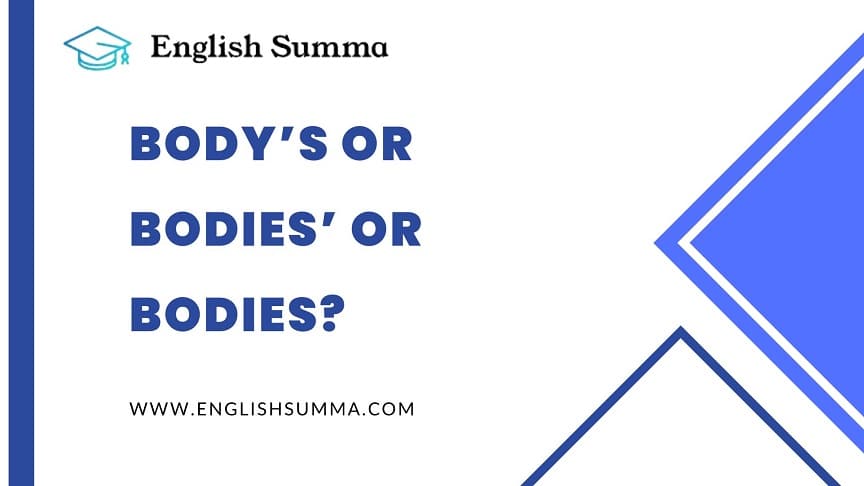When indicating possession or ownership in English, we use what are called possessive forms. The possessive form helps identify that something belongs to someone or something else. There are some key rules for forming possessives depending on whether the noun is singular, plural or irregular. Now let’s discuss whether use Body’s or Bodies’ or Bodies?
Singular Possessives
To make a singular noun possessive, simply add an apostrophe + ‘s’. For example:
- The body’s internal organs were studied by the medical student.
- The animal’s habitat was threatened by deforestation.
This format works for most singular nouns, including those ending in ‘s’. For example:
- The bus’s route goes through the city center.
There are some exceptions to this rule, but we’ll cover those later.
When using a singular noun to indicate possession or ownership, be sure to use the apostrophe + ‘s’ format.
Learn the correct possessives: Community’s or Communities’ or Communities?
Plural Possessives
To make a plural noun possessive, simply add an apostrophe after the ‘s’. For example:
- The bodies’ locations were mapped out.
- The animals’ feeding patterns changed with the seasons.
This works for all regular plural nouns, including those not ending in ‘s’:
- The children’s toys were all over the floor.
So when indicating possession or ownership for a plural noun, just add an apostrophe after the ‘s’ to form the possessive.
Irregular Plural Possessives
There are some irregular plural nouns in English that don’t end in ‘s’. These include words like ‘men’, ‘women’, ‘people’, etc.
To make these types of words possessive, we add an apostrophe + ‘s’, just like with singular nouns. For example:
- The people’s representative put forward a motion.
- The women’s rights movement has had many achievements.
So for irregular plural nouns that don’t end in ‘s’, use the apostrophe + ‘s’ format for the possessive form.
Don’t make these mistakes again and learn what to use for Friday Possessive: Friday’s or Fridays’ or Fridays?
Singular Words Ending in ‘s’
There is one exception to the general singular possessive rule. For singular nouns ending in ‘s’, you can choose to add just an apostrophe after the existing ‘s’. For example:
- The witness’s testimony was hearsay.
OR - The witness’ testimony was hearsay.
Both options shown above are acceptable. Just be sure to be consistent within a single piece of writing.
Plural Words Ending in ‘s’
Unlike the singular case just mentioned, for plural nouns ending in ‘s’, always add just an apostrophe to form the possessive. For example:
- The witnesses’ accounts of the accident were conflicting.
Never use an additional ‘s’ for the possessive form of regular plural nouns ending in ‘s’.
Using Possessives for Groups
When indicating possession or ownership for a group of people, often referred to with a plural noun, there are a couple of options.
First is the regular plural possessive formation using just an apostrophe. For example:
- The managers’ meeting went overtime.
However, for some groups, especially more formal bodies, you may see:
- The committee’s decision was unanimous.
This committee-style possessive can be used for singular collective nouns like ‘committee’, ‘government’, ‘company’, etc.
The key is to identify whether the group is being referred to as a single entity or a collection of individuals.
Read More: Family’s or Families’ or Families?
Summary
The main rules for forming possessives in English are:
- Add apostrophe + ‘s’ for most singular nouns
- Add just apostrophe after ‘s’ for regular plural nouns
- Add apostrophe + ‘s’ for irregular plural nouns not ending in ‘s’
- Use either format for singular nouns ending in ‘s’, but be consistent
- Only use the apostrophe for plural nouns ending in ‘s’
- Apply the committee-style possessive to formal singular group nouns
Following these guidelines will ensure you use the correct possessive form of nouns, whether they are singular or plural, to indicate possession or ownership. Pay attention to irregular nouns as you write.

